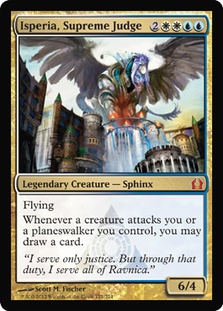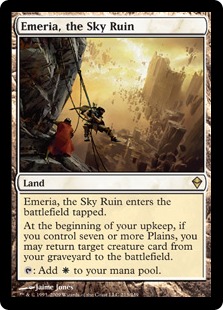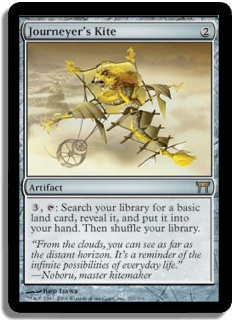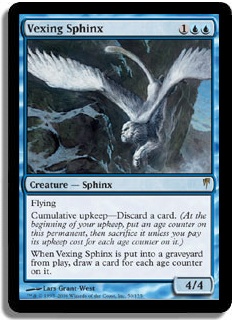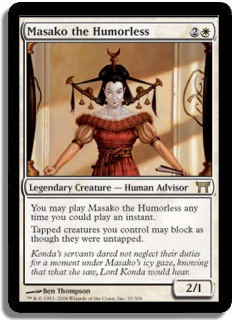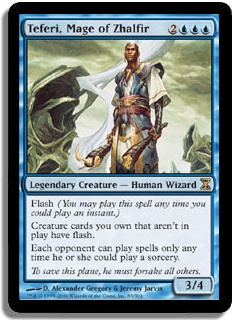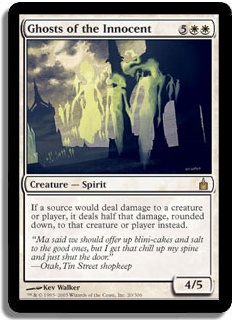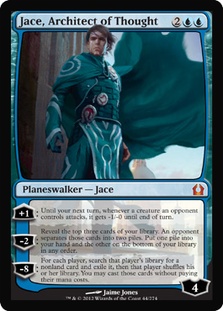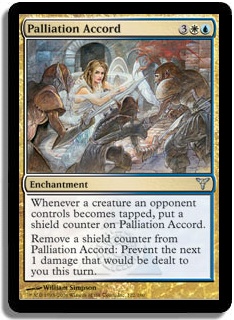Cassidy and I were given a little bit of a weird job: build some new Commander decks using a pretty simple restriction. A lot of the Commander cards I love to throw into decks are at this point older than the younger portion of our readership, so we were told to stick with the Modern time period as a deck design limitation and see what we could do. Oh, and while we’re at it, we had to pick one of only five new Commanders to build our decks. Let’s just say Cassidy got to pick first.
Lauren, our illustrious editor, has clearly orchestrated this challenge for one singular purpose: to pry my Winding Canyons from my cold, dead hands. Well, touche, mademoiselle editrix—if I am to play by your game, I will have to make exception to my standard rule of “always playing Winding Canyons,” but I see your machinations and will take them further than you might possibly have imagined.
The editorial staff of this here site here are not the only people able to set new rules. The Azorius guild excels at it, so it was plain to see which of these five new Commanders would be mine for the project once you layer it through a certain level of ornery sarcasm.
The Azorius are fascinated with minor bureaucratic obstruction as a means to lawful enforcement. Why wait until after a crime has been committed, after all, to send the Azorius law-mages out to act as judge and jury on the streets before? (Whether or not this is also a tongue-in-cheek nod to my time working within Occupy Wall Street, I leave to the readership, and for the especially curious readership, I encourage them to do some not-quite-required reading and Google “National Defense Authorization Act.” It’s not just the Azorius law-mages who rely on boredom to detain would-be offenders; legal research makes your eyes want to crawl out the back of your head just to escape.)
When contemplating a new deck or a redesign of someone else’s cherished and beloved (yet malfunctioning) instrument, I tend to focus on the nature of the commander when figuring out what direction I am being led in. In this case, however, as much as I want to embrace the commander as a card, I also want to honor the nature and flavor of the Azorius guild and their seemingly arbitrary bureaucracy that limits one’s ability to do much of anything quite the way you wanted to…which means that the theme of the deck is going to be new rules. The Azorius guild is the pinnacle of achievement for shifting one little comma or using one little bureaucratic rule to shift life to the way they think it ought to be lived, and cards that do that are going to be welcome in Isperia’s new deck regardless of whether there is a mechanical overlap with the card itself.
Isperia actually leads me in two directions, not just one. At first glance, it’s a big, flying Craw Wurm with a really interesting Propaganda effect attached to it. People really have a strongly negative experience when one player has a Rhystic Study in play and tend to use that as solemn justification to attack that player at all costs until the enchantment or the player is no more. Either one’s fine, and it’s not like we hold any grudges or anything, but the proper response to a Rhystic Study is a judicious application of overwhelming force—as it should be.
But when the only thing you have to do to avoid ticking over into that Rhystic Study is not save mana but just don’t attack Steve, Steve may not get very many free cards but Steve also probably isn’t going to get attacked. Isperia, Supreme Judge might be exceptionally well-oriented in a deck that taxes and punishes attacks aimed your way, making the price to turn sideways even a single attacker so high that it is simply easiest to turn sideways at other people instead and deal with the other problem later.
Then there’s the miraculously convincing effect of “I will stop trying to murder YOU when YOU take out some of that stuff over there…” but that particular social side effect is outside the scope of this discussion. That’s not really optimistic, and we want to build optimistically because hey, if we’re not having fun, why are we playing Commander? Pessimistically grumbling “well you’re all just going to blow up all of my stuff and attack me” is a harsh mood-killer, and here we were being all positive. New rule: let’s be positive here!
Phew. So much better.
The other direction that tempted me was forcing the opponent to attack you, so that you triggered the card drawing effect massively even as you took a light-as-a-feather blow thanks to the preventive countermeasures that rules setting cards we’re going to include will undoubtedly work towards. You can point towards cards like Gideon Jura as the centerpiece of just such a strategy, as you can set the dude with the horde of Saproling tokens to attack Gideon and draw you twenty cards if you play the situation right. Who doesn’t like their commander just handing them twenty cards for free?
Between these two ideas, it was easy to put together a rough sketch and figure out where the interest was. I wanted to pursue a defensive deck that turtled up a little but not so exclusively that it stopped interacting with the opponent’s board. We don’t want to rely on a table full of permanents just to lose everything in the face of the first Oblivion Stone to inevitably come down; we just want to nudge people away from focusing attention on us as we set up for a good, long game with interesting rules interactions (and maybe a wee bit of bureaucratic red tape provided by yours truly).
It is an exploration of voluntary detention, not a Prison deck, because Lauren said “Modern” and thus I couldn’t add the first and most obnoxious card that came to mind because Winter Orb has thankfully never been reprinted since we last abused it back in the good old bad old days of Fourth Edition. We are exploring voluntary detention insofar as we’re just cordoning off this area and then sitting in it minding our own business. Well, that’s a lie I guess, because we’re definitely going to be minding your business too. Azorius is a nosy guild that way, after all.
Building up the mana base was pretty easy, as I started looking for the rules setting cards and realized I do not play with Emeria, the Sky Ruin nearly as often as I think I should. The commitment to having a lot of Plains in play is a hard one but worth pursuing in this case even if it means that the focus on white mana instead of blue means we are going to forego a lot of the cheap deck manipulation I otherwise love to start with. But hey, Ponder and Preordain are banned in Modern anyway, and I’d hate for Lauren to call me a cheater if I included them. Ancestral Visions is clearly right out.
The Basics: 6x Island, 12x Plains
The Rest:
Hallowed Fountain comes as assumed. After all, there’s no Tundra to be asked for in this Modern era, so the next best thing will have to suffice and has thankfully been rendered quite plentiful these days thanks to the Return to Ravnica. It even counts as a Plains for Emeria and lets us use four of the five Zendikar fetchlands to find either blue or white mana, even though they’re all enemy color fetchlands.
Terramorphic Expanse, Evolving Wilds, Bant Panorama, Esper Panorama — Cheap fetchlands that we can reuse with Crucible of Worlds, which obviously we are playing both because it is awesome in a slow, grindy, long-game deck like we’re planning to be and because it sets a new rule, even if it isn’t an especially interesting one.
Scalding Tarn, Misty Rainforest, Arid Mesa, Marsh Flats — Expensive fetchlands that are either basic lands that cost a life or extra copies of Hallowed Fountain if we haven’t found the one Hallowed Fountain yet. Price is no object in general concept, after all. I don’t have to worry about the fact that when Cassidy did his deck challenge for this particular thought experiment last week he put up a rolling price list for the deck as a whole and this deck’s going to end up being multiples of that value. I never agreed to posting the deck’s price—new rule, I’m not gonna! Nuh-uh!
Glacial Fortress, Azorius Chancery, Sejiri Refuge, Mystic Gate, Nimbus Maze, Reflecting Pool — A nice leavening of nonbasic lands to help smooth out the color balance, the only one I’m not really in love with is Reflecting Pool, which I am noting with a hint of bitter recrimination I wanted to be Command Tower but the Commander decks aren’t legal in Modern. What a silly restriction—I don’t get to play Sol Ring or Command Tower? Are you sure this is even a Commander deck we’re building?
Mistveil Plains — A little bit of recursion is a good thing, and we’re going to have lots of white permanents just lying around, I suspect. While I don’t have this particularly in mind as something very interesting I am relying on as part of the deck’s proper functioning—I’ve done silly Mistveil Plains / Sunforger recursion tricks in recent memory—it’s still an excellent free addition.
Tolaria West — For finding that Emeria more often. Wait, which Emeria?
Emeria, the Sky Ruin — This Emeria. I typed it so many times in this section at this point that I could have sworn I’d written it down already. One of the key advantage engines I want to build the deck around is a grindy deck that can start to overpower on the cheap as the game goes long, and this adds the new rule of ‘I get something free every turn!’ that can prove an insurmountable advantage.
Mystifying Maze — The best of a very limited set of options. Maze of Ith is one I don’t usually reach for since I’d rather tap for mana than tap for free and am not afraid of even reasonably weighty activation costs in my defensive land arrangement because I don’t expect to need them particularly early on anyway. I tend to want Kor Haven before Mystifying Maze in a deck able to support the color white, but it’s not from a Modern set, so that’s a no-no too. Between Mystifying Maze and Prahv, Spires of Order, let’s face it—when the effect is six mana to use, the rent is too damn high.
This gives us 37 lands, with a virtual freebie in Expedition Map, and since I’m talking already about artifacts that are virtual extensions of the mana base, we’ll cover the artifacts next. They’re limited in scope because artifacts die easy, and I want to focus on them just for specific effects and to fill holes.
Sensei’s Divining Top — If you want to take the slow, patient approach and apply a thousand paper cuts to kill your opponent, use Sensei’s Divining Top. It’ll do the trick. Is Sensei’s Divining Top banned in Modern? Yeppers. Is that ridiculously silly? Yeppers. Am I going to let that get in the way of me playing the most obvious auto-include spell in the format just because I was given sort of arbitrary set restrictions to build from?
Not a chance! It seems a reasonable presumption this was more for “knowing what the cards do!” and “card access” principles, and since the Divining Top is only legal in Commander, Legacy, and Vintage, there is not exactly a whole ton of price pressure pricing this out of reasonableness for inclusion. We are the Azorius—we make the rules here. No webpage is going to tell me I can’t play Sensei’s Divining Top in this deck unless Sheldon Menery wrote it.
Expedition Map — When you have one land that’s fancier than the others, you’re going to want ways to Tutor it up. The more chances I get at finding Emeria, the Sky Ruin by the middle stages of the game, the happier I am since I am aiming to be reliant on it to help dictate the phase of the game at which the deck moves from passive resistance to actually trying to win the game with the resources to hand.
Journeyer’s Kite — I like set-up card advantage, and Journeyer’s Kite is an early-game drop you can sit back with open mana on and not waste your development. There is, in fact, nothing I like better in a deck with blue mana than to keep my early mana untapped and threaten countermagic or reactive spells when all I actually want to do is spend three mana every single turn in pursuit of more free lands out of my deck. Just because I could have Hinder doesn’t mean I do… I just really like getting my land drops for free. I’m not going to be building in a whole lot of card advantage into this deck since it’s more a white deck than a blue one, so we’re going to rely on permanents like this to give us free lands and just draw a haymaker every turn.
Crucible of Worlds — Same plan, though considerably easier on the turn-by-turn mana requirements. It also requires drawing one of the fetchlands to go with it, which is why so darn many of them were included, so it’s not a perfect plan by itself. It makes up for that two-card nature of it doing what I want it to do by being able to recur Emeria when it has been destroyed to keep the party rolling on my side of the board.
Oblivion Stone — Finally, an artifact that does something instead of allowing me to do nothing professionally. Oblivion Stone is the best blow-up-the-world spell I could hope for since it lets me pick not my stuff and keep the defensive permanents I want on the board even as I answer the real problems.
Mindslaver — If you note, the mana base has no Academy Ruins, so this is just for fun rather than the kind of card you deserve to get punched for. In this deck and most especially with this commander, this is really just a fun trick to work with—you can seize someone’s turn and make them attack you, reaping a whole lot of cards in the process. Non-traditional uses of Mindslaver are the kinds of uses I can get behind, not the Mindslaver-every-turn stuff that gets boring far beyond the point of being hysterically funny when you make someone combo kill themselves or wipe out the rest of the table with an enemy’s resources.
You can use it to cripple someone or force a team-up attack to oust a player you couldn’t handle by yourself, but by intentional design it’s really there as an interesting way to get more play out of the Commander. Oh, and it’s really funny when the new rule is “Do exactly as I say, no questions or smart-talk out of you…”
We move next to the creature base, though I often leave that for last and work on the spells instead. I want to build around things that apply new rules to the table, and many of them turned out to be creature cards. I expected to find a pile of enchantments and start having to ask myself where I was going with that, but instead I have as many creatures as lands, which is atypical for my design balances. I tend to find myself finishing around 30 creatures usually, and even my Animar deck that loved casting as many creatures as possible as rapidly as possible still didn’t get past 35. I hit 37 by using all of the ones that make new rules, so we’ll talk about that cast of characters next.
Supporting Roles:
Serra Ascendant — Too good not to play for the most part. An early play that provides a strong life buffer and is very swingy, and there is going to be enough life gain going on (even though I generally don’t like it) that even later in the game it should still be big instead of small.
Weathered Wayfarer — Land Tax isn’t legal in Modern, and in Commander I reach for the Wayfarer first anyway. Good for searching out whatever land suits you, especially good at helping turn Emeria on either by finding it or by finding more Plains to work with it.
Phantasmal Image — Most appreciated because of the Sun Titan that gets snuck in later, Phantasmal Image is great in the context of the Commander format… Think of it as a sorcery speed Hero’s Demise that can do other things or potentially be recurred easily. While the new banning of Primeval Titan actually cuts back a bit of its relevance, because let’s face it if there was one thing you really wanted to copy it was Prime Time, this plays excellently as a supporting cast member.
Vexing Sphinx — This isn’t so much a ‘new rule’ as it is an interesting subgame. You can’t keep it around forever, but it is a cheap and efficient creature which is also a great toy to return with Sun Titan and lets you filter through a clunky draw or a mana flood by building up some age counters. Considering how more than a few cards put lands in your hand, this is a great way to potentially get those back as actually spell-like resources.
Seht’s Tiger — An excellent way to blunt an offensive pointed your way and is especially good at getting paid off of Isperia with at little or no cost to your health or board position. Just sort of a surprising card in general because it can counter a Cruel Ultimatum just as easily as it can counter an Overrun fueled offensive. It’s worth including for both sides but really shines bright when the commander is online.
Lightkeeper of Emeria — I was looking for a bit more life gain and a bit more long game and ran into the grudging realization that I didn’t really like life gain… But a good exchange rate is a good exchange rate, and Lightkeeper of Emeria is another good thing to do with all of those plains we otherwise seem to be dragging into the deck.
Solemn Simulacrum — Is Solemn Simulacrum; i.e., it does everything in this format you want to be doing. A good mix of bonus resources and mana ramp in a color combination that usually only gets one of those two halves of a bargain.
Sunblast Angel — One-sided Wrath effects are at a premium, and Sunblast Angel may not hit every problem but at least it never hits anything of yours. Keeping the opponents from building up too many resources, no matter where they’re pointing them, is a job worth doing.
Sun Titan — I was looking at all of the cards I was playing and finding that sweepers that hit artifacts or enchantments made me really sad. Then I noted how many of these cards were three mana or less and built a very good shell around Sun Titan, like that Phantasmal Image and even Vexing Sphinx as a possible card advantage outlet. Then I remembered that Sun Titan can also play Crucible of Worlds very well with all those fetchlands, and it was clear that just running a Sun Titan was what this deck really wanted to be doing.
Myojin of Cleansing Fire — Another good Wrath effect, one that has a few interesting side benefits while you’re at it, like mana-free instant-speed use and the occasionally useful indestructible body. There will be at least one reason to appreciate having expensive white creatures in the deck, too, so there will be upsides to including him besides just for utility’s sake.
Trendsetters:
Ethersworn Canonist — New rule: no more than one (nonartifact) spell per turn. This should potentially help gum up the works with spell-based combos because it’s hard to build up a storm count or protect a Tooth and Nail when that’s the only spell you’re allowed to play on your turn.
Azorius Guildmage — New rule: triggered abilities require my permission. That it also happens to do a reasonable job at creature control is a value-added feature, which in the choice between this and Voidmage Husher suggested it be the choice. Azorius Guildmage is easier to get to repeat but more vulnerable and less flexible, but ultimately not even the surprise instant-speed effect of the Husher could convince me to play it as a ‘rule-maker.’
Eight-and-a-Half-Tails — New rule: good luck killing anything without my permission. Mr. 8.5 protects any class of permanent controlled by any player, so things going off the table will require either mass removal or your consent, which is a good place to be for a controlling deck.
Masako the Humorless — New rule: my tapped creatures can block. This is a card I am actually surprised hasn’t picked up more in Commander because its rule-changing power is subtler in Magic than it is in, say, Vampire: the Eternal Struggle, where something that grants exactly this sort of ability (“Wake with Evening’s Freshness” is what it’s called in its default form in that game) is a crucial, fundamental underpinning of the game. Masako may not do much more than grant virtual theoretical vigilance, but the surprise effect and the fact that it sets an odd rule into place give it the nod here even if vigilance is not exactly overpowered.
Opal-Eye, Konda’s Yojimbo — New rule: good luck getting something I don’t want to happen past me. With enough mana, you can protect yourself against virtually anything (so long as we’re talking just one thing—a full Avenger of Zendikar’s worth of Plant tokens are still a pain in the butt), and this works on damage-based removal spells as well for protecting your creatures. The ways in which this alters combats your creatures are involved in or can protect Esperia without any mana warps how the game plays out, and this is another oddly underrated Kamigawa-block potential commander.
Angel of Jubilation — New rule: no sacrificing things or paying life for effects. Interacts positively against both Necropotence and Greater Good, meaning that while this looks like it mostly just hits fetchlands (no paying life!) or Sakura-Tribe Elder (no sacrificing creatures!), it actually stacks up favorably against some very high-power cards.
Linvala, Keeper of Silence — New rule: no activated abilities on your creatures. Linvala has a lot of impact in Commander, enough so that I put this particular legendary Angel pretty high on the list of ‘great mono-white Commander,’ solely on the effectiveness of that control countermeasure. Even decks that don’t think this does very much against them will need to reexamine their creature base because so many creatures we tend to include either have a direct comes-into-play trigger or an immediately usable or at least significantly powerful activated ability. The latter half of those are entirely hosed by Linvala, making this a sticky rule to work around because it turns great creatures into dumb vanilla beaters.
Magus of the Tabernacle — New rule: you’re gonna have to pay your taxes. Magus of the Tabernacle emulates that fantastically controlling land, the Tabernacle at Pendrell Vale, which is of course countered by tapping your own legendary land if you have a Gaea’s Cradle handy. Token strategies really don’t like having to pay to keep their manufactured armies around, while pretty much anyone else finds this to be a stumbling block on their forward progress.
Windborn Muse — New rule: if you want to attack me, it’s going to cost you. Alongside that similarly discouraging effect on your commander, this should help persuade people to attack elsewhere, or if it can’t do that it at least puts a realistic limitation on the number of creatures that are actually able to attack you in the first place. A solid defense and a new rule, both in the same card.
Silent Arbiter — New rule: one-on-one fighting only—now I want a good, clean fight. This is an actual referee, not some awkward WWF mockery thereof, though recent current events have shown us even ‘official’ refs can be a mockery of themselves when you try to break an NFL game official lockout by hiring scabs fired by the Lingerie Football League for incompetence. Silent Arbiter forbids people from attacking with swarms which helps defend you and make friends, since unlike the Windborn Muse above or your commander this helps slow down the game and protect everyone, not just yourself.
Rhox Faithmender — New rule: double the life! While life gain is going to be only a small portion of this deck, life gain happens enough that doubling it as a rule is spiffy.
Teferi, Mage of Zhalfir — New rule: only when I say so. I started the Dear Azami series with a strategic analysis of this card as a fundamental choke-point on where the game’s interactivity breaks down (back in the dark ages of Commander on the internet, when this was still called ’99 Problems’ and “The 99%” was not something I’d ever heard of before to go with that, i.e., when I still had ‘free time’). That link can be found here and brings us simply to including Teferi as the rule-breaking rule-breaker that just rewrites the fundamental concept of how time works in Magic.
Aeon Chronicler — New rule: I get an extra card in turn and there’s no permanent lying around for you to blow up to stop that. Aeon Chronicler just has a weird effect, and one that I greatly appreciate in Commander. Again, however, it pains me that the restriction on Modern-legal cards only prevents me from adding Winding Canyons, which would (like Teferi) allow for wonky end-of-turn suspends with whatever mana I didn’t use defending myself. Major source of card advantage and quite a credible threat as well while we’re at it.
Voidstone Gargoyle — New rule: permanent and/or spell X, stop that. Both Pithing Needle and Meddling Mage on the same card, Voidstone Gargoyle may not seem like an impressive card in a singleton format, but then you add the fact that you can name any player’s Commander and keep it firmly in the command zone and we’re in business. The versatility to stop a spell or a key permanent gives us additional utility, and so while you’ll (almost) never stop two copies of the same permanent, stopping one player’s commander as a preemptive measure may be something they’re entirely unable to deal with. Green decks don’t pack a lot of creature removal, after all.
World Queller — New rule: death to (permanent type X)! If you don’t have a planeswalker, well, you can cut everyone else down one of those on your upkeep. Ditto for the other permanent types: you get to pick the kind of permanent you really need to target and aim accordingly. It’s a very solid politics card, as it lets you take out limited resources if one player has a key permanent that is exposed and does so repeatably and with no mana cost past the initial investment.
Ixidron — New rule: everyone back in the bug suits! Morph is a really weird creature ability conceptually to begin with—these things are running around in these odd suits or shells or whatever, so you can’t tell if it is a Scorned Egotist or the mighty Akroma herself cruising around all stealthy-like. Then you add the idea of forcing awesome creatures into the bug suit who don’t know how to get out and things get downright hilarious.
River Kelpie — New rule: anything comes out of your graveyard, I get a card. There isn’t exactly overwhelming synergy with this effect, just some good added value since recursion is a preferred mode of interaction in Commander and thus you’ll presumably get more than your fair share of cards for this investment. ‘Ways to get more cards!’ was one of the things I wanted to find a new and more interesting way to work in, so I added River Kelpie instead of the editrix’s namesake Mulldrifter, perhaps just to be ornery. (Your flying fish totally gets it if I have to follow more arbitrary rules in the future, Mademoiselle Editrix…)
Admonition Angel — New rule: good luck keeping that around! With a fairly steady stream of lands flowing plentifully, the landfall ability should be easy to activate, and free Oblivion Rings are a pretty good thing to add to your 6/6 flier. While it may not remove them forever, you usually don’t need to, and with fetchlands the ability to defend your own permanents from destruction for later rescuing is an interesting side benefit.
Crovax, Ascendant Hero — New rule: death to token creatures. While this may not be entirely true in all cases—white token creatures feel strangely invigorated, in fact—this does have a very solid ability tacked to a creature that is darn near impossible to actually kill to make up for that. Crovax is so resilient it is a pain to work around, and things that give your opponents hives trying to deal with them are the kind of permanents you want to involve in when playing Commander.
Patron of the Kitsune — New rule: no attacking without a life for me. Another minor life gain card, this blunts attacks and just pads your total, again whether they go at you or attack someone else entirely… And best of all, you even get paid when you attack someone else! Patron of the Kitsune adds to the defensive overlap that is a minor package intended to get people attacking elsewhere and taking the pressure off your back, but it can also just provide a healthy chunk of life back at minimal investment.
Ghosts of the Innocent — New rule: boffer weapons only. With Ghosts of the Innocent in play we add yet another layer of defenses, as all attacks are automatically blunted to half strength and direct damage is halved as well unless it’s direct loss of life. This overlaps to help everyone else at the table, which can help keep a neighbor around a while longer even as it defends you yourself.
Drogskol Reaver — New rule: life gets me a card! I was looking for more interesting life gain cards, and this one came up as a weird rule setting one that is a major blowout alongside, say, Patron of the Kitsune no matter which side of the attack phase you’re on. The potential to get unanticipated benefits intrigued me, and I have been waiting to fit this monster into a Commander deck since I first saw it because it’s an Ophidian that works twice as hard, not just a fat lifelinked flier.
Elesh Norn, Grand Cenobite — New rule: your stuff stinks, mine’s awesome. If Crovax was an obvious inclusion with corner-case difficulties taking out particular colors of token hordes, Elesh Norn is the merciless tormentor of Kithkin Soldier tokens everywhere as it cares not what it kills, merely for whom the bell tolls. (Hint: not you.) Adding both a sizable creature buff to your army of surprisingly low toughness dudes and a state-based effect that cripples entire strategies makes this a high-power inclusion, unlike several of the ‘rules makers’ we’ve included so far. (Sorry, Ghosts of the Innocent, but it’s true—you just don’t swing very hard.)
Angelic Arbiter — New rule: attack or develop, but not both. Angelic Arbiter is something I tend to avoid because it’s either entirely irrelevant or highly polarizing, but we’ve got a theme of making rules and Angelic Arbiter makes very, very sticky ones.
Avacyn, Angel of Hope — New rule: my stuff doesn’t break. Adding the words ‘indestructible’ to all of your permanents is an incredibly potent ability, making Avacyn a flagship threat that helps keep your board in play while you work on the opponents’ board positions with your now one-sided Wrath effects.
Stormtide Leviathan — New rule: if it doesn’t fly or swim, it stays put. Another solid defensive countermeasure, it has not one but two new rules added in, rebranding all lands as Islands (unfortunately, in addition to their usual types, unlike Spreading Seas) and adding a pretty severe restriction on what’s allowed to attack. Overlapping defenses are just a powerful thing to have since if you just keep throwing things into play eventually something will stick, and they will tend to have multiplicative effects on each other as they do so. Who wants to attack through a Stormtide Leviathan, Ghosts of the Innocent, Silent Arbiter, and Patron of the Kitsune? Not a lot of people.
It That Betrays — New rule: sacrificial fodder comes back on my side of the table. More thematic than anything else since we aren’t really forcing a sacrifice-based theme, this can be potentially awesome with World Queller or just ‘for value’ with each attack phase yielding you two more lands thanks to the annihilator trigger. It definitely has a rule setting ability and one that will make weird things happen in corner cases, and there is always the dream that All Is Dust will happen or there will be an awesome Living Death turn and there will be explosions in fun and spectacular fashion.
This leaves us room for nineteen spells, and we’ll flesh them out with some defensive countermeasures, a few rules setting cards just for good measure, and what help we can muster with triggering Isperia’s card draw feature or surviving attacks that might be pointed your way.
Gideon Jura — The first piece of cardboard that came to mind after Isperia, Supreme Judge, as Gideon forces the attack that Isperia lets you draw a pile of cards off of. It’s so obvious it’s almost uninteresting, but Gideon doesn’t have much of a following in Commander so it’s still interesting as far as I’m concerned since I love finding ways to force attacks in interesting fashion.
Jace Beleren — A support role card draw effect, one that works well with the Sun Titan that I described as ‘the thing I most want to be doing’ and happens to share very nicely for realpolitik purposes. Sharing is caring, after all, until you ‘care’ someone’s deck to death.
Jace, Architect of Thought — All three modes are fantastic here since the +1 is a defensive overlap that works with all the rest of your defensive overlaps, the -2 is abusable to friends who want to split three-or-zero piles, and the ridiculous ultimate is big-spell madness in a format where legendary Eldrazi and Insurrection are not oddities but commonplace staples. The ultimate scales both to the number of players and the ridiculous quality of Commander’s haymakers, meaning you can in fact ultimate this and get some ridiculous spread like Time Stretch, Insurrection, True Conviction, and Tooth and Nail out of the deal.
Porphyry Nodes — New rule: small things die easy. This is a color shifted ‘reprint,’ giving us Drop of Honey in the color that makes more sense to have it in, and this is an amazingly potent early play to blunt the offensive you see from low-curve commanders like Radha or Isamaru. A small investment for a small but steady effect, this is an interesting oddity I thought would be worth exploring here since we want to prevent massive armies from building up and directing them elsewhere when they do. This plays both countermeasure and politics at the same time by letting you break ties as you see fit.
Future Sight — New rule: I’m playing off the top of my library…literally. Future Sight is high power card advantage of an unconventional type and is another added benefit to all those fetchlands we’re playing as you can save them and keep digging for spells in order to chain as many things together for free as possible and get the most value out of it. It’s also cute with Sensei’s Divining Top, but that’s the kind of combo that probably gets you punched in the face for abusing, so you have to remember: be responsible, not the greediest person alive. You do not need to draw all of the cards.
Aura of Silence — New rule: artifacts and enchantments your opponents cast cost more. I was originally thinking we’d follow the ‘new rule’ theme with Trinisphere and things like that then decided no one ever thinks those cards are harmless and there will be serious repercussions for looking like a lockdown deck. Aura of Silence, however, only taxes the most annoying classes of spells, can turn around to kill one too, and has a lot of synergy with Sun Titan yet to be explored, as I haven’t seen that one come up yet (and now really want to).
Ghostly Prison — New rule: see also Windborn Muse above. It’s just a Propaganda effect to make people go elsewhere, and overlapping effects that do in fact make people go elsewhere or at least lay off hitting you as hard as they can are an active theme for this deck, whereas Ghostly Prison is usually just added on the grounds of being ‘good in Commander.’ I am certain this is the first time I’ve actually added this card to a deck in my time here at Dear Azami, so it just goes to show, even I don’t swear off everything forever. Everything in moderation, including moderation, after all.
Curse of Exhaustion — New rule: that guy’s on time-out. Unlike Rule of Law, which penalizes everyone, the Curse of Exhaustion singles someone out as a possible abuser and puts the brakes on what they’re trying to do, leaving everyone else unbothered by this development (yourself included). An appropriate punishment and preventative countermeasure if you know whom to apply it to. (Hint: it’s probably a blue mage.)
Palliation Accord — New rule: charge up the damage prevention machine! Unfortunately unlike Patron of the Kitsune, this doesn’t fire up when you attack, but it makes up for it by charging up for mundane utility purposes too like tapping elves for mana. Yet another overlapping (and interesting—never seen this one in a Commander deck before!) defensive countermeasure, and another one that helps protect you without using mana to do so.
Dawn Charm — Part utility spell and part Fog, this card has no bad modes to pick from, even if some of them are a little narrow. First time you counter Cruel Ultimatum, Overwhelming Forces, or Fact or Fiction with it, you’ll be a true believer, but regenerating a permanent that is about to be destroyed or potentially having a Fog to lean back on in case of emergencies are both very key uses of the card.
Shining Shoal — Something fun to draw into if there’s a massive attack with Isperia in play, and the oddity that rewards you for having expensive bodies like Myojin of Cleansing Fire in your deck because it scales based on the cost of the card so exiled. Shining Shoal is a weird and very powerful free spell and one that I think deserves more attention in Commander than it’s gotten, as Sheldon with his recent adventures exploring Reflect Damage can attest that manipulating who gets punched by what can be a very powerful effect.
Add ‘works as a pitch spell’ to that and you can forgive it for not necessarily being the most efficient at preventing large swathes of damage, because doing so for free and doing so in a more highly targeted manner—as creature removal—adds two major bonus utilities to it that more than make up for the fact that sometimes what you really want it to do costs seventeen mana instead of Reflect Damage’s always affordable five.
Path to Exile — I like having at least one cheap pinpoint removal spell, and within the set restrictions of Modern, that means the first one is Path to Exile instead of Swords to Plowshares.
Supreme Verdict, Austere Command, All Is Dust — A trio of sweeper spells, each with beneficial modes or bonus utilities that make them worthwhile. Supreme Verdict is the new, uncounterable kid on the block for when you really, really need to make sure that mass removal effect happens, while Austere Command shifts modalities to whatever you need to happen most (while leaving the stuff you really want to keep still there for you) and All Is Dust combos with It That Betrays for fun every great once in a while and also gives you a card that answers a lot of problems literally no other card does because its sweeper-based forced sacrifice effect is pretty close to unprecedented in the game of Magic.
Hinder, Cryptic Command, Swift Silence, Time Stop — Four countermagic spells for when you really need a counter, we’re playing counter-light because I don’t think they’re highly critical to a control build in this format and want to pick only the ones with the most cross-benefits as we can find. Hinder can knock out a player’s commander for the entire game, and Cryptic Command has both versatility and that dash of card advantage that means it at least replaces itself as it does whatever you need it to be doing.
Swift Silence can potentially answer odd situations with a nice bit of card advantage to it for the next time you encounter someone playing a weird Haze of Rage build or find someone’s been reading Sheldon’s latest thoughts and tries to make your life uncomfortable with a Hunting Pack. And Time Stop’s the ‘in case of emergency, break X!’ answer to literally any problem that can possibly occur since you can dodge any bullet by ending the turn in response and permanently if it’s not based on a card that is already in play. It can even just be a second Fog effect to go with that Dawn Charm, it’s so versatile.
Putting that all together, we get a complicated mix of bureaucratic red tape that hinders the opponent’s ability to land a blow on you and make it count, perfectly in keeping with our chosen guild and new Commander. As if it were meant to be, I even opened a copy of Isperia to play with in my Prerelease deck this weekend, so surely the stars must be aligned…for gumming people up in petty and minor bureaucratic nightmares and telling them to go punch someone else if they want to let off some steam.
Creatures (38)
- 1 Eight-and-a-Half-Tails
- 1 Patron of the Kitsune
- 1 Opal-Eye, Konda's Yojimbo
- 1 Solemn Simulacrum
- 1 Myojin of Cleansing Fire
- 1 Masako the Humorless
- 1 Weathered Wayfarer
- 1 Windborn Muse
- 1 Silent Arbiter
- 1 Ghosts of the Innocent
- 1 Azorius Guildmage
- 1 Vexing Sphinx
- 1 Ixidron
- 1 Teferi, Mage of Zhalfir
- 1 Aeon Chronicler
- 1 Crovax, Ascendant Hero
- 1 Magus of the Tabernacle
- 1 Voidstone Gargoyle
- 1 Seht's Tiger
- 1 River Kelpie
- 1 Ethersworn Canonist
- 1 World Queller
- 1 Admonition Angel
- 1 Lightkeeper of Emeria
- 1 It That Betrays
- 1 Linvala, Keeper of Silence
- 1 Serra Ascendant
- 1 Angelic Arbiter
- 1 Sun Titan
- 1 Stormtide Leviathan
- 1 Sunblast Angel
- 1 Elesh Norn, Grand Cenobite
- 1 Phantasmal Image
- 1 Drogskol Reaver
- 1 Avacyn, Angel of Hope
- 1 Angel of Jubilation
- 1 Rhox Faithmender
- 1 Isperia, Supreme Judge
Planeswalkers (3)
Lands (37)
- 12 Plains
- 1 Reflecting Pool
- 6 Island
- 1 Azorius Chancery
- 1 Hallowed Fountain
- 1 Terramorphic Expanse
- 1 Nimbus Maze
- 1 Tolaria West
- 1 Mistveil Plains
- 1 Mystic Gate
- 1 Bant Panorama
- 1 Esper Panorama
- 1 Glacial Fortress
- 1 Arid Mesa
- 1 Emeria, the Sky Ruin
- 1 Marsh Flats
- 1 Misty Rainforest
- 1 Scalding Tarn
- 1 Sejiri Refuge
- 1 Evolving Wilds
- 1 Mystifying Maze
Spells (22)
- 1 Sensei's Divining Top
- 1 Ghostly Prison
- 1 Hinder
- 1 Shining Shoal
- 1 Journeyer's Kite
- 1 Time Stop
- 1 Aura of Silence
- 1 Future Sight
- 1 Crucible of Worlds
- 1 Oblivion Stone
- 1 Mindslaver
- 1 Palliation Accord
- 1 Swift Silence
- 1 Dawn Charm
- 1 Porphyry Nodes
- 1 Austere Command
- 1 Cryptic Command
- 1 Path to Exile
- 1 Expedition Map
- 1 All Is Dust
- 1 Curse of Exhaustion
- 1 Supreme Verdict

Also, in case you forgot, future decks will follow the new rule: old rule: has Winding Canyons In It template, just as we had before. Modern restrictions were interesting to play with once, but you’ll still have to pry my favorite land out of my cold, dead hands to get it away from me.
Want to submit a deck for consideration to Dear Azami? We’re always accepting deck submissions to consider for use in a future article, like Jacob’s Skullbriar, the Walking Grave deck or Phil’s Garga Zol, Plague Queen deck. Only one deck submission will be chosen per article, but being selected for the next edition of Dear Azami includes not just deck advice but also a $20 coupon to StarCityGames.com!
Email us a deck submission using this link here!
Like what you’ve seen? Feel free to explore more of “Dear Azami” here, in the Article Archives! Feel free to follow Sean on Facebook… sometimes there are extra surprises and bonus content to be found over on his Facebook Fan Page, as well as previews of the next week’s column at the end of the week! Follow Cassidy on his Facebook page here, or check out his Commander blog — GeneralDamageControl.com!
 |
I am Simic. The reasoning I applied was as follows: I ascribe to the use of one’s rational mind to understand reality but understand that while we have higher minds, we also have some pretty buggy wiring that challenges rationality with deep-carved instincts. Blue covers the rational mind, while green covers the use of instinct to find the path forward, and it is through the use of the rational mind to re-shape one’s natural instincts that most nearly matches my philosophy for living life. |

